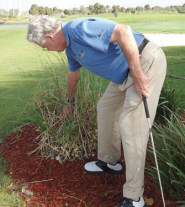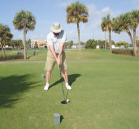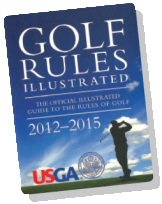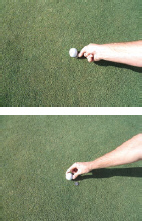By The Rules
Golf Rules Illustrated 2012-2015, published in association with the United States Golf Association, contains every rule in one of the world’s most popular games, including all the new and revised Rules that came into play as of January 2012. Last published in 2008, this new, updated edition is fully redesigned with over 100 illustrations for easy reference and will help you to better understand the game of golf, no matter what your level of play.
With a quick guide, FAQs and all-new incidents, images and artwork, this clear, detailed book allows you to come to terms with even the most difficult situations quickly and easily. Obstructions, bunkers, out of bounds, lost balls, unplayable lies, water hazards, loose impediments, and casual water are just a few of the rules that are illustrated and addressed. Now available for purchase by visiting www.usga.org.
USGA AND R&A RULES CHANGES FOR 2012
Every four years, the USGA and R&A get together to revise and update the Rules of Golf. The year 2012 is one of those years, and some changes are considered major and some minor.
As time goes on, the Rules seem to get more liberal, and this year is no exception. Some golfers are surprised at the loosening of the Rules to the extent that we are seeing, but they seem to be reflecting an attitude of implementing more common sense into the Rules. Here is a list of the major changes that were implemented at the start of the year:
Definition of ball addressed. Prior to 2012, through the green, a ball was considered addressed once a player both assumed his stance and grounded the club. Now, the ball is considered addressed once the player has grounded his club without regard to whether or not he has taken his stance. In a hazard, since a player is not permitted to ground his club, this effectively means that addressing the ball no longer takes place.
Time of starting. A player who is late for his tee time, but is present and ready to play within five minutes of his starting time, will be penalized two strokes and not disqualified. Previously, a player was disqualified unless a local rule, as summarized in the previous sentence, was invoked. The local rule will no longer be necessary.
Smoothing sand or soil in hazard. A player is permitted to smooth sand and soil in a hazard prior to making a shot, provided that this is not done to test the condition of the hazard or to improve the lie of the ball or intended area of the swing.
Ball moving after address. If it is known or virtually certain that the player did not cause the ball to move after addressing it, the player incurs no penalty and must play the ball from the new position.
 Rules of amateur status. From the USGA website: “An amateur golfer may now enter into a contract and/or agreement with his national golf union or association, provided the player does not obtain any financial gain, directly or indirectly, while still an amateur golfer.” Also, an amateur may now sign with an agent or sponsor, providing that the amateur receives no financial gain and is not required to play in certain golf tournaments or events. Finally, an amateur may receive subsistence payments, not exceeding the actual expenses, to assist with general living costs, from the player’s national union or association.
Rules of amateur status. From the USGA website: “An amateur golfer may now enter into a contract and/or agreement with his national golf union or association, provided the player does not obtain any financial gain, directly or indirectly, while still an amateur golfer.” Also, an amateur may now sign with an agent or sponsor, providing that the amateur receives no financial gain and is not required to play in certain golf tournaments or events. Finally, an amateur may receive subsistence payments, not exceeding the actual expenses, to assist with general living costs, from the player’s national union or association.
This is also the first time that the USGA and R&A have jointly published the Rules. Previously, each organization published their own versions of the Rules, although the wording was identical. In addition to the major changes above, minor changes and revisions to the Rules of Golf have been made. To see these changes and to get more information on the Rules, please visit www.usga.org.
WHAT’S ALLOWED IN HAZARDS?
Late last year in the final round of the Chevron World Challenge, Tiger Woods’ ball was in a water hazard. Many watching on television saw his club touch the grass that was in the hazard before he made his swing, and they felt this was a Rules violation.
In fact, what Woods did was not a penalty, and highlights some longstanding myths that surround what may and may not be done in a hazard. In this article, we hope to clear up the confusion and misinformation that abounds when it comes to what’s allowed and what’s not in hazards.
First, let’s address the Woods case. Rule 13-4 lists as prohibited actions testing the condition of the hazard, touching the ground in a hazard with a hand or a club, and touching or moving loose impediments prior to making a stroke. One myth is that a player cannot touch the grass in a water hazard with a club prior to making a stroke, but if you look at what Rule 13-4 states, this is not the case. Decision 13-4/8 further clarifies by stating that grounding of a club on grass in a hazard occurs “When the grass is compressed to the point that it will support the weight of the club.”
Sometimes there may be tall grass in a water hazard and the ball is not readily findable. Some people think that it is prohibited to move the grass in an effort to search for the ball, but again, this is not the case. Rule 12-1 states, “In searching for his ball anywhere on the course, the player may touch or bend long grass, rushes, bushes, whins, heather or the like…” Such actions are allowed as long as they don’t improve the lie of the ball, the area of intended swing or stance, or the intended line of play.
Loose impediments in a hazard are another area of misinformation among many golfers. One belief is that it is never permissible to move a loose impediment in a hazard prior to making a stroke, but sometimes such action is indeed okay. It is only when both the ball and the loose impediment lie in the same hazard that the player is not allowed to move the loose impediment. If, for example, a player must stand in a bunker to hit a ball that is outside the bunker and he will be standing on a pine cone, the player is allowed to move the pine cone without penalty. Rule 23-1 is very clear on this: “Except when both the loose impediment and the ball lie in or touch the same hazard, any loose impediment may be removed without penalty.”
Tour player Brian Davis highlighted the loose impediment rule in regards to touching two years ago at the Heritage tournament in Hilton Head, South Carolina. His ball was in the water hazard just left of the 18th green during a playoff against Jim Furyk. During his backswing, he touched, but did not move, a loose impediment that was in the hazard, and incurred a two-stroke penalty.
Moveable obstructions may be moved at any time in a hazard, whether or not the ball is also in the hazard. Water hazard stakes also constitute moveable obstructions, so it is okay to remove them before playing a stroke, even if the ball is in the hazard. Relief from immoveable obstructions, however, is prohibited if the ball is inside a water hazard. This also applies if the immoveable obstruction lies outside the water hazard. Relief from an immoveable obstruction inside a water hazard is allowed if the ball itself lies outside the water hazard.
To simplify the immoveable obstruction rule, if the ball is outside the water hazard, a player may obtain relief from any immoveable obstruction if it interferes with the player’s stance, swing, or the ball’s lie, regardless of where the obstruction is. If the ball is inside the water hazard, the player may not obtain relief, regardless of where the obstruction is.
Taking penalty relief from a regular water hazard involves only two options: Replaying the previous shot under stroke-and-distance, or dropping behind the hazard on an extension on the line from the hole to the last point of entry into the hazard. A widely held belief is that the ball can be dropped on the line of flight, but this is not the case. Also, some players think that it is okay to drop within two clublengths from the last point of entry, but this is only allowed for lateral water hazards.
Drop zones for water hazards may be established. A local rule sometimes invoked on the PGA Tour makes it against the Rules to use a drop zone that is closer than where the ball last entered the hazard, but this is not a local rule normally used for drop zones in most tournaments. In other words, most of the time it is okay to use a drop zone that is closer to the hole than the last entry point into the water hazard.
A player may place his golf bag or other clubs in the hazard prior to making a stroke. It is also permissible to touch the hazard with a club or hand in an effort to prevent falling or to move an obstruction in the hazard.
An unplayable lie may be declared in a bunker but not in a water hazard. For water hazards, the normal penalty rules apply as described in Rule 26.
Rules myths and misconceptions abound in the game of golf, and Rules regarding hazards are some of the most prevalent. Some of them may seem eccentric, but having a good grasp of them is important in order to play the game correctly.
COMMON RULES VIOLATIONS IN TOURNAMENT PLAY
With the Rules of Golf being almost 100 pages (not counting the Local Rules and Appendices), and with the wording written in legal-type language, it’s no wonder that the rules get violated in everyday play. What’s surprising is that violations of routine rules happen in high-level tournament play. You would think that the players in these events would be among the most rules-savvy, but the fact is that often, they are not. Annika Sorenstam made news a number of years ago for attending a USGA rules seminar – the first professional player in memory to do such a thing.
We have observed the following rules being broken with some regularity in tournament play:
Failure to declare a provisional ball. This might be the most common violation in tournament play. When a player hits a ball near out of bounds or which might be lost, more often than not, you don’t hear the player declare he or she is hitting a provisional ball. Usually they say something like, “I’ll hit another.” Unfortunately, this isn’t good enough. Decision 27-2a/1 states, “The player’s statement must specifically mention the words ‘provisional ball’ or must make it clear that he is proceeding under Rule 27-2a.”
It’s uncomfortable when a player doesn’t do this, because the rest of the players in the group who know this is a violation tend not to say anything to the player. What should you do if the player simply says he’s hitting another? We recommend asking him if he’s hitting a provisional ball. When he answers “yes,” he fulfills the latter part of Decision 27-2a/1. You might come across as nit-picking, but in all fairness the player should not put the rest of his group in such an awkward position.
 Moving growing vegetation excessively. It happens to all of us sooner or later. We hit a wayward shot that ends up under a tree. We can play the shot, but it requires moving branches in order to get in there and play it. What is allowable? The rules allow us to bend and break branches only in “fairly” taking our stance.
Moving growing vegetation excessively. It happens to all of us sooner or later. We hit a wayward shot that ends up under a tree. We can play the shot, but it requires moving branches in order to get in there and play it. What is allowable? The rules allow us to bend and break branches only in “fairly” taking our stance.
What is meant by “fairly”? Decision 13-2/1 gives some guidance: “In taking his stance for the selected stroke, the player should select the least intrusive course of action which results in the minimum improvement in the position or lie of the ball, area of intended stance or swing or line of play.” It is permissible to “back into a branch or young sapling if that is the only way to take a stance for the selected stroke, even if this causes the branch to move out of the way or the sapling to bend or break,” and also to “bend a branch of a tree with the hands in order to get under the tree to play a ball.” What’s not permitted, for example, is “bending an interfering branch with the hands, a leg or the body in taking a stance when the stance could have been taken without bending the branch.”
As you can see, there is some interpretation necessary for individual situations, but the general rule of thumb is for the player to take the least intrusive way possible into the tree(s) to hit the shot.
Marking and replacing the ball incorrectly. Padraig Harrington was hit with this rule in 2011 for replacing his ball on the green in a slightly different position than from where it was marked. In picking up his coin, Harrington accidentally moved the ball slightly with his finger, unbeknownst to him. It took high-definition television to reveal the violation.
More commonly, in tournament play we see someone mark the ball and then carelessly, or perhaps deliberately, replace the ball in a different position. Usually this involves replacing the ball slightly more forward than where it originally was. Players who do this tend to slide their coin all the way under the ball to mark it, and then replace the ball somewhat in front of the marker. It’s not a big deal in one sense, but it’s big enough to be a two-stroke penalty if the player goes ahead and putts the ball. Less common, but still an occurrence, are players who mark the ball in one manner (such as on the side of the ball) and then replace the ball in front of the marker.
Finally, we have seen players simply rotate the ball on the ground in order to line up the label for putting without marking the ball. They must figure that, since they are not “moving” the ball, they do not need to mark it before rotating it. Decision 18-2a/33 declares this a one-stroke penalty “for touching the ball other than as provided for in the Rules.”
 Teeing off ahead of the markers. This is surely out of carelessness, but it does happen. In stroke play it’s a two-stroke penalty; in match play there is no penalty, but the opponent can require the player to re-hit. The best course of action in a stroke play tournament is to inform your fellow-competitor that he is ahead of the markers before he hits the ball.
Teeing off ahead of the markers. This is surely out of carelessness, but it does happen. In stroke play it’s a two-stroke penalty; in match play there is no penalty, but the opponent can require the player to re-hit. The best course of action in a stroke play tournament is to inform your fellow-competitor that he is ahead of the markers before he hits the ball.
Identifying ball in an incorrect manner. If a player needs to identify a ball, the correct procedure according to Rule 12-2 is to notify his marker or fellow-competitor of his intentions, mark the ball and then lift it. Common violations are to fail to inform anyone of what they’re doing, or to pick up a ball without marking it.
Caddie stands on/or near extension of line of play. Rule 14-2b says that it is against the rules to position a partner or a caddie on or near an extension of the line of play behind the ball. In events where caddies are common, such as US Open qualifiers, this rule is tested often, if not often broken. Most fellow competitors won’t say anything to the violator. After all, calling penalties is difficult, and this infraction seems to be a “no harm, no foul” type of violation to many. Ideally, if a competitor notices a fellow-competitor’s caddie standing on the extension of the line of play behind the ball, the competitor would notify the fellow-competitor before he made a stroke. The only problem with this is that sometimes the caddie does move out of the way at the last instant. To bring this to the fellow-competitor’s attention when this was going to happen anyway, can certainly put a strain on the collegiality of the group.
The bottom line is that competitors are responsible for knowing and playing by the Rules of Golf. Although it’s nice if we take pre-emptive action to save them from a penalty, it can’t always be done. If players violate a rule, that’s their fault and they shouldn’t blame others for calling a penalty. But, as we know, wrongdoers frequently lash out, which makes it difficult in a self-policing environment such as a golf tournament. Nevertheless, it’s something that has to be done for the integrity of the tournament.








